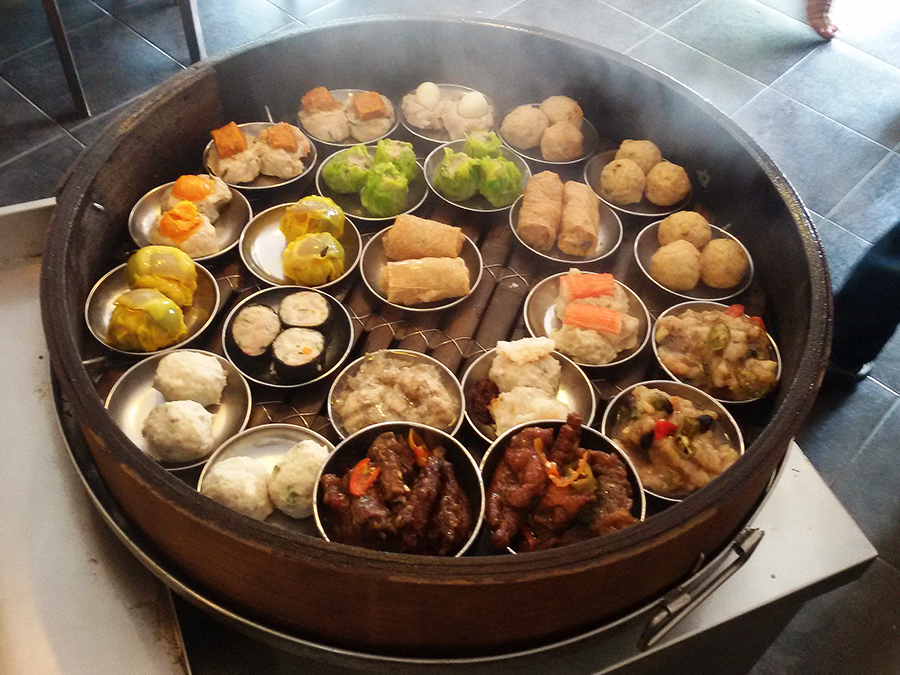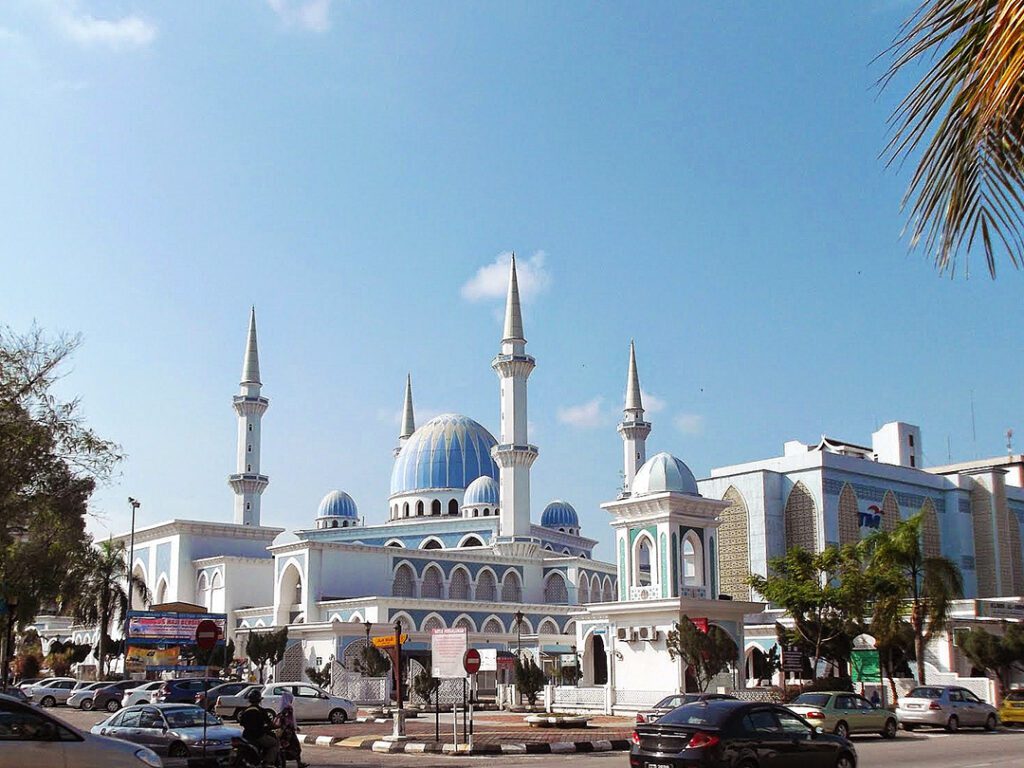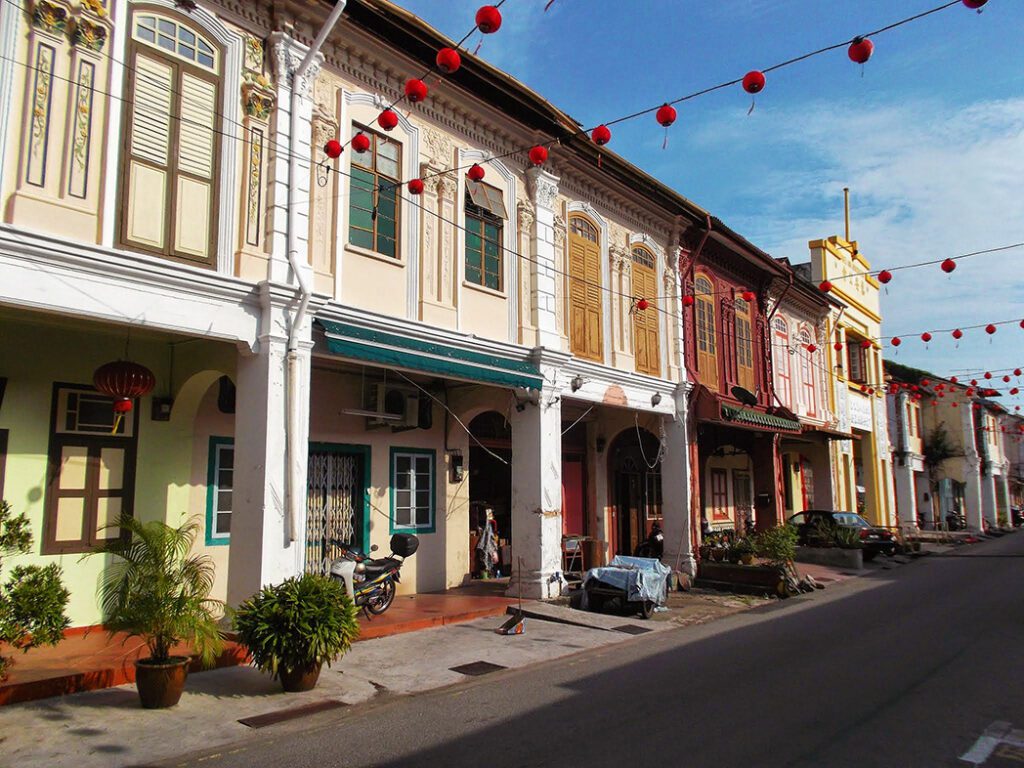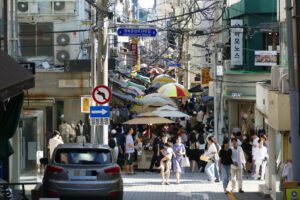Since the Malayan people consists of various ethnicities and different religions, Malaysia is definitely Asia’s most fascinating melting pot.

Also, when it comes to tourism, the country has been stepping up a notch. However, it’s by far not overrun by tourists. Apart from the fascinating cultural mix, you’ll still find unspoiled nature and empty beaches.
Ethnic Mix
Malaysia’s strongest suit is definitely the diversity of its people.
Different ethnicities live together peacefully. After all, there is a Street of Harmony in many cities. In those streets, a Hindu Temple, a Buddhist Temple, and a Mosque are standing wall to wall.
The population is a mix of almost 70 percent Malay, 23 percent Chinese, and 7 percent Indian. A total of 32 million people form Malaysia, Asia’s Melting Pot.

Countrywide, you can immerse yourself into totally different cultures – even as you stay in small towns.
Malaysia’s History
The reason for this diversity lies, of course, in the country’s history and mainly the colonial past.
Early Settlers
Already in the first century, the Chinese and Indians began to establish trading ports and towns in Malaysia.
In the 14th century, Islam began to spread. Eventually, the Malacca Sultanate was founded in the 15th century. Quickly, it became an important trading place.
Malacca was first conquered by the Portuguese in the 16th century. Eventually, the Dutch took over. I’m referring to this hegemony also in the language section below.
The British Take Over
End of the 18th century, the inevitable British Empire took over and with it the infamous British East India Company.
Penang, Malacca, Singapore, and Labuan became the Straits Settlements.
However, until 1909, Thailand controlled the four northern states Perlis, Kedah, Kelantan, and Terengganu.
In WWII, the Japanese Army invaded Malaya apart from other Asian countries.
During this time, ethnic tensions and nationalism grew quickly.
Consequently, Britain’s post-war plans of uniting the administration of Malaya under a single crown colony were strongly opposed.

Also, suspicion of the Indian population grew. Indians were seen as the British’s protégés. This, by the way, is disturbingly similar to the root of ethnic conflicts in Sri Lanka.
On the other hand, the Chinese were envied for their relative wealth.
The worst ethnic conflicts happened in 1969 during the post-election riots. Depending on the sources, the number of fatalities during these conflicts differs very strongly.
However, on August 31, 1957, the Malaya Federation gained independence. By then, it consisted of nine Malay Sultanates as well as the Straits Settlements Penang and Malacca.
Recommended Reads
There are two excellent books dealing with these topics. The most complete one is The Long Day Wanes: A Malayan Trilogy by Anthony Burgess. It takes ethnic and sociological issues into focus.
Another one is The Singapore Grip by J.G. Farrell. This novel describes rather the life of the British colonialists around WWII.
Both are gripping yet educational reads.
Malaysia Today
Today, Malaysia is a constitutional monarchy. The country consists of the so-called Malay Peninsula in the West and East Malaysia on the island of Borneo. The South China Sea divides the two roughly equal parts.
In the sparsely populated eastern states of Sarawak and Sabah, indigenous peoples make up half to two-thirds of the population. However, they are not ethnic Malays.
There are also indigenous people on the Malay Peninsula, but in smaller numbers. They are referred to by the collective term Orang Asli.
The country has natural resources and raw materials such as tin, rubber, palm oil, and petroleum. But Malaysia is also home to the automobile manufacturers Inokom, Perodua, and Proton.

The most prominent company is probably the oil multinational Petronas. Even if you haven’t been to Malaysia yet, you have probably seen the impressive Petrona towers in pictures. They are in the center of Malaysia’s capital Kuala Lumpur.
Since the beginning of the 1990s, there has been rapid industrial development. Actually, it has pushed the country up into the ranks of the up-and-coming emerging countries.
All in all, Malaysia is economically as well as politically one of the most stable countries in Southeast Asia.
Practical Information
How to Get There
Coming to Malaysia, almost everyone will arrive in Kuala Lumpur. Probably at KLIA, which is short for Kuala Lumpur International Airport, located about 45 kilometers south of the city center.
It’s a huge airport, nevertheless, fantastically organized.
Getting downtown, there are a couple of different options. In most cases, visitors are choosing the KLIA express. This train takes you quickly to Kuala Lumpur Sentral, the huge and maybe a bit intimidating railway station.
Obviously, you can also take a cab. To prevent unpleasant surprises, you can prepay already at the airport. You just tell the lady at the ticket window where you’re going. Then you pay, she hands you a voucher – and off you go to your final destination. This is, after all, more convenient than going to the Sentral station.
Most importantly, if you are two people or more, it is even cheaper.
Getting Around
Once on the Malayan peninsula, there is a very good and reliable train going from Kuala Lumpur to Butterworth. If your destination is on this route, it’s highly recommendable.
From Butterworth, you can quickly cross to Pulau Penang by ferry.

There is an excellent bus system. The quality of the vehicles, however, differs strongly. From new, modern, and climatized coaches to pretty shady ones. Often, the quality of the drivers is…questionable.
They tend to be quite rude, do whatever makes them happy and comfortable. If they like to smoke while driving, they are smoking and respond pretty indignant if you ask them not to.
I’ve had my generous share of arguments – you can read about it in an earlier post.
Also, they seem to be always in a rush. Why else would they speed as they do, the wheels barely touching the ground?!
Some rides actually made my blood freeze.
In 2017, the Malaysian Road Transport Department took measures. They encourage the public to report bus drivers exceeding the speed limit, smoking, or using a mobile phone while driving. You can submit the report via WhatsApp +60 – 11 – 51 11 52 52. Apparently, there were more people like me not happy sitting in big clouds of smoke.
Or flying pretty low over the highway.
I’m usually not a big fan of reporting people. However, in this case, it could save lives.
Private Transport Companies
Besides regular public transport, there are many private companies offering shuttles. They travel between the most important touristy places such as Kuala Lumpur, Malacca, the Cameron Highlands, and the Taman Negara.
This service is a bit more expensive than regular buses. However, it’s much more efficient and comfortable. And faster.
Albeit, this is not always a good thing…
If you have limited time to spend on the peninsula, you might consider using these private companies. In general, it’s a door-to-door service.
Where to Stay
Obviously, there are all kinds of very reasonably priced accommodations ready for travellers all over Malaysia. If you are on a budget, you find friendly hostels. And if you can splurge, you get even a five-star hotel for under 100 US$.
You’ll find the accommodations I chose listed in the respective guides linked below.
I like to know where I will lay my hat head as I get to an unknown city. Hence, I always make a reservation in advance. As a matter of fact, booking.com* is a great platform with lots of choices for every budget*:
What to Eat
The fact that Malaysia consists of different ethnic groups is also reflected in local dishes.

A Malaysian meal basically consists of a plate of rice accompanying several small dishes.
Apart from rice, noodles are very popular, too.
Nasi lemak, in English cream rice, is Malaysia’s national dish. Also, satay, grilled skewers with a delicious peanut sauce, is one of the country’s most famous foods.
However, when in Malaysia, you should definitely try also the wonderfully aromatic Indian dishes. If you’re brave enough, you can also go for some true Chinese cuisine. Believe me, it’s not like your average Panda Express at all.

This being said, for people in Malaysia, food is an important part of their culture. Consequently, you’ll find fantastic dishes everywhere. Highly recommendable are the night markets where you can sample delicacies at unbelievably cheap prices.
What to See
I’m an avid solo-travelling woman. Since solo-travel doesn’t equal solitude, I love to join organized tours here and there. They allow me to meet fellow travellers – for just a short moment or a lifelong friendship.
Therefore, here are some great ideas of what to do during your stay in Malaysia. Especially if you have only a short time to stay, they’ll enable you to make the best of it*:
You’ll find more ideas in the post on the individual places.
Money
In 1975, the Ringgit replaced Malay Dollar. One Ringgit is divided into 100 Sen.
The exchange rate is 1 US$ = 4,41 MYR current rate resp. 1 €UR = 4,80 MYR current rate (as of April 2023).
There are ATMs practically everywhere. Credit cards are widely accepted.
Language
The official language in Malaysia is Malay. Often referred to as Bahasa – which translates to language – it is extremely similar to Bahasa Indonesia.
I gained some basic knowledge for my trip to Bali. It’s amazing how easily bahasa can be learned. Especially since it’s written in Latin letters.

Interestingly, there are still remains from Portuguese. For instance, sepatu for shoes or meja for table. But mostly there is a strong Dutch influence such as gelas for glass or handuk for towel. These words are also very similar in German.
Then, everything related to time like hours and weekdays is derived from Arabic. As a language aficionado, I loved diving into these structures and enjoyed studying.
Yes, Indonesian is one of the languages babbel offers. As usual, the first lesson is free. It supplies you with the most important words to interact with people.
Communication and Connection
Like during most of my trips where European roaming is not available, I did not get a national SIM card. I rather used free WiFi. There was a connection to the internet in many places and, of course, at basically every hostel and hotel.
If you insist on being online 24/7, you can, of course, get a SIM card. There are four main cell service providers in Malaysia: Maxis, Cellcom, Digi, and U Mobile. You can get cards at shops located adjacent to major supermarkets and at malls.
Plugs in Malaysia are mostly type G as they are also used for instance in the United Kingdom.
The standard voltage is 230 to 240 V and the frequency is 50 Hz. Whereby, nowadays, all these chargers for phones, readers, and computers have integrated adapters. In general, voltage and frequency don’t really matter.
Gone are the days when you blew your electric appliances since you forgot to switch them from 110 to 220…good memories.
You’ll find comprehensive travel info in my post World’s Most Complete Travel Information – an indispensable globetrotter-classic.
The Route I Travelled
Places I Visited












Pinnable Pictures
If you choose to pin this post, please use one of these pictures:



Did You Enjoy This Post? Then You Might Like Also These:
MIRISSA – Beach Hopping
Guide to ANURADHAPURA and MIHINTALE
The Perfect Itinerary for Three Days in BUSAN
From Saigon to HO CHI MINH CITY – a Guide to Vietnam’s Largest Metropole and Three Day Trips
Why the City of ULSAN is Absolutely Worth a Visit
How to Experience the Folk Heritage of Korea in ANDONG
Culture Villages in Korea: Real People, Real Art
Guide to the CAMERON HIGHLANDS, Malaysia’s Fruit Bowl
Note: I regularly complete, edit, and update this post- last in April 2023.
* These are affiliate links. If you buy something through this page, you get the best deal. I also do get a small commission so I can run this blog. Thank you so much for supporting me!








Malaysia is so dynamic – thanks for sharing the history on why it has become a melting pot! love it!
I am unfamiliar with Malaysia and had no idea they were so very culturally diverse. I love the integration and acceptance of multiple faiths with the larger communities.
Nice post. Thanks for sharing.Thailand tour packages from Kerala
Thank you very much for your valuable information. can you help me in finding out more detail on Malaysia visa
Vacation in Malaysia is always a dream. I am planning a solo Malaysia trip want to have a idea about all the places that i can visit. I found great
Malaysia tour packages here ,even this can be helpful
Well, that's wonderful MEGA guide for Malaysia. Thanks for taking time to write it. In my opinion the most worth to visit places in the country are Cameron Highlands and Penang island, I would love to come back there! Also Borneo island is on my list as I haven't explored it properly.
It's really good to know about different ethnicities living in Malaysia peacefully. I had recently been to Kuala Lumpur and visited a buddhist temple and a hindu temple which were located on the same street. It's a beautiful country for sure!
Wow Malaysia has some lovely places with stunning views and definitely an amazing country
Oh man – I have been thinking about visiting Malaysia soon and your post decided it for me! I must go! Thank you especially for including the history and cultural information – always SO helpful and really intriguing to me!
Really nice and elaborate post. I had gone to Kuala Lumpur recently and I really didn't enjoy it. But now I know why.
Ahhh Malaysia is just an amazing country! I love how detailed your guide is. It brought many memories back for me 😀
Somehow, I heard that Taman Negare is the best thing to see. I am not entirely sure why, but my friends told me it is one of the best natural objects.
Great guide and beautiful pics! We've been to some of these places recently but your post has shown me there's still a lot left to see and do!
I would love to return to Malaysia again. Its one of few countries in the world I can visit visa free. Bookmarking your post as there is so much I still have yet to see in the country.
Your blog is very informative, meaningful and to the point. Being a traveller blogger i find you have a very good writing sense due to which you explain details about many destination perfectly, Your blog is like books of Lonely planet for various travel destination. If someone required destination information your blog is enough instead of searching anywhere. Keep it up your meaningful blog writing. I recently returned from an Amazing Indian Golden Triangle tour Package which was arranged by Ghum India Ghum, travel agent in Delhi, you can tie up with them if you want.
tour operator in Delhi
travel Agents in Delhi
That's a very useful guide. Malaysia is such a great and multicultural place. I especially love KL.
Malaysia is one of the few places in Asia we're yet to visit. Sounds like you've had great travel experiences there. Thanks for pulling all the information together, I'm sure it will come in handy when we decide to go there.
I recently went to KL but I didn't explore a lot. This blog has given me hope to make a second visit.
Ever since I moved to Singapore, Malaysia is on my list. I will visit soon. Thanks for sharing the guide.
I've spent next to no time in Asia, so I'm always intrigued by how different it is from the places I've been in North America and Europe. What a great guide for anyone heading to Malaysia!
This sure is a wonderful summary of an itinerary for Malaysia. I love the way you added follow-up posts on the locations you visited, helps alot to plan your own trip 🙂
Such a great post, I would love to visit Malaysia one day x
I really like the books you recommended, I have read the Malayan Trilogy by Burgess and loved it. I think the book by Farrell is also a part of a trilogy including other countries but my memory is failing me. I am finally heading to Malaysia in March and will save your post!
Thanks for such a great article, it's always interesting to find out a little bit of history of the country you travel to. While we've been to quite a few destinations in Malaysia, there is still so much to discover!
Wow you sure covered a lot of ground in Malaysia! Love Perhentian, Penang and Malacca. I hope you ate yourself silly in Penang and Malacca. their peranakan cuisine is exquisite. You made me laugh about the drivers always being in a rush. Its those crazy freeway sin KL where there are no traffic lights. They literally fly!
I have yet to get to Asia in my travels but would love to go! Your guide is so complete, very extensive travels through Malaysia, I will bookmark this article for a great reference.
I've been to Asia but missed Malaysia, we should have included it when we went to Singapore as they are close. You really took your time visiting Malaysia, great tips on places to visit.
I'll be visiting Kuala in a few months, and this is giving me some serious wanderlust! I had considered visiting Langkawi and Penang in the past, so I'll have to get to those later.
Great guide but yikes- I'm not sure I'd ride the bus system! Bummer that it reaches everywhere but the drivers are so bad!
What a wonderful quick guide to Malaysia. I've never been there or read much about the country, so the history is fascinating.
I love this history about Malaysia. I would love to visit the country and hope to get there soon. I love taking public transportation as sometimes it gives you a peek into real life. Great to know they go all over the country.
Sometimes it is not so bad if a countries not overrun by tourists. We have certainly met many friendly Malaysians who encourage us to visit. So good to know that there are buses that cover the whole country. Although I probably would prefer a private shuttle. Thanks for this guide to Malaysia. (LD Holland)
I didn't see enough of Malaysia when I was there. Cameron Highlands is the place I really want to see, it looks so beautiful there!
Great guide! I am planning a trip to Malaysia in the near future and this will definitely be helpful, thanks for sharing!